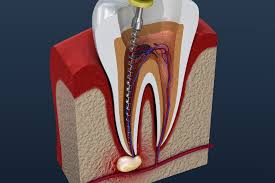Few dental procedures evoke more fear than root canals. For decades, they’ve been surrounded by myths, horror stories, and unnecessary anxiety. But how much of that reputation is actually deserved? The reality is that modern root canals are not only effective but also far less painful and invasive than many people believe.
This article will explore the truth about root canals, breaking down the pain factor, the actual procedure, and the recovery process. If you’ve been told you need a root canal, or you’re simply curious, understanding the facts can help ease your fears and allow you to make informed decisions about your dental health.
What Is a Root Canal?
A root canal is a dental procedure used to treat infection or inflammation in the pulp of a tooth—the soft tissue inside that contains nerves and blood vessels. When the pulp becomes infected due to decay, trauma, or deep cracks, it can lead to severe pain, swelling, and even tooth loss if left untreated.
Root canals are designed to save the natural tooth. During the procedure, the dentist removes the infected pulp, cleans and disinfects the root canal system, and then seals the tooth with a filling or crown to protect it.
Modern root canals have a high success rate and are a critical tool in preserving teeth that would otherwise require extraction.
Debunking the Pain Myth
Let’s address the biggest misconception: that root canals are unbearably painful. This belief is largely outdated.
Thanks to advances in anesthesia, technology, and techniques, today’s root canals are no more uncomfortable than getting a routine filling. Local anesthesia completely numbs the area, and most patients report only mild discomfort during the procedure—if any at all.
The pain often associated with root canals usually comes before the treatment, caused by the infection itself. In fact, the root canal is what relieves that pain.
If you’re worried about the procedure, many clinics also offer sedation dentistry options to help you relax during treatment.
When Is a Root Canal Necessary?
Not every toothache requires a root canal, but there are several warning signs that may indicate one is needed:
- Persistent pain, especially when chewing
- Sensitivity to hot or cold that lingers
- Swelling or tenderness in the gums
- Darkening or discoloration of the tooth
- Pimple-like bumps on the gums
Only a dentist can determine whether a root canal is required, usually through a combination of examination, X-rays, and patient symptoms.
Ignoring these signs can lead to the spread of infection, worsening pain, and the eventual loss of the tooth.
The Root Canal Process Step-by-Step
Understanding what happens during a root canal can make the procedure feel less intimidating. Here’s a breakdown of the typical steps:
1. Diagnosis and Preparation
Your dentist will first take X-rays to assess the extent of damage. If a root canal is necessary, they’ll numb the area with local anesthesia to ensure your comfort.
2. Accessing the Pulp
A small opening is made in the crown of the tooth to reach the pulp chamber. Special instruments are used to carefully remove the infected or dead tissue from inside the tooth.
3. Cleaning and Shaping
The inner chambers are cleaned, shaped, and disinfected. Rotary tools and irrigation systems ensure that all bacteria and debris are removed thoroughly.
4. Sealing the Canal
Once clean, the root canals are filled with a biocompatible material called gutta-percha. The tooth is then sealed with a temporary or permanent filling to prevent reinfection.
5. Final Restoration
In most cases, a crown is placed on the tooth during a follow-up visit to restore its strength and appearance. This is especially important for back teeth, which undergo a lot of pressure during chewing.
Recovery After a Root Canal
Recovery from a root canal is typically straightforward. Most patients experience mild soreness or sensitivity for a few days, especially if the infection was severe before treatment. This discomfort can usually be managed with over-the-counter pain relievers such as ibuprofen or paracetamol.
Here are a few tips to ensure smooth healing:
- Avoid chewing on the treated tooth until it’s fully restored.
- Maintain good oral hygiene, including brushing and flossing.
- Attend any follow-up appointments to monitor healing and complete the restoration.
If you notice unusual swelling, pain that worsens, or signs of infection, contact your dentist immediately.
Long-Term Success and Tooth Longevity
When performed correctly and followed by proper restoration, root canals have a success rate of over 95%. A tooth that has undergone a root canal can last just as long as your natural teeth, especially when supported by good oral care and regular dental visits.
It’s important to understand that a root canal treats the internal damage, but the tooth still needs external support. That’s why the crown is a vital part of the process—it strengthens the structure and protects it from future damage.
Cost and Insurance Coverage
The cost of root canals varies depending on the complexity of the procedure, the tooth involved, and the location of the dental clinic. Molars tend to be more expensive due to their complexity.
However, most dental insurance plans cover a portion of root canal therapy because it is considered a restorative, medically necessary procedure. It’s far more cost-effective than tooth extraction followed by a dental implant or bridge.
Conclusion: Root Canals Are a Tooth-Saving Solution
Despite the myths and fears surrounding them, root canals are a safe, effective, and relatively pain-free way to treat dental infections and save your natural teeth. With modern dental techniques, patient-focused care, and proper aftercare, there is little to fear from the procedure.












